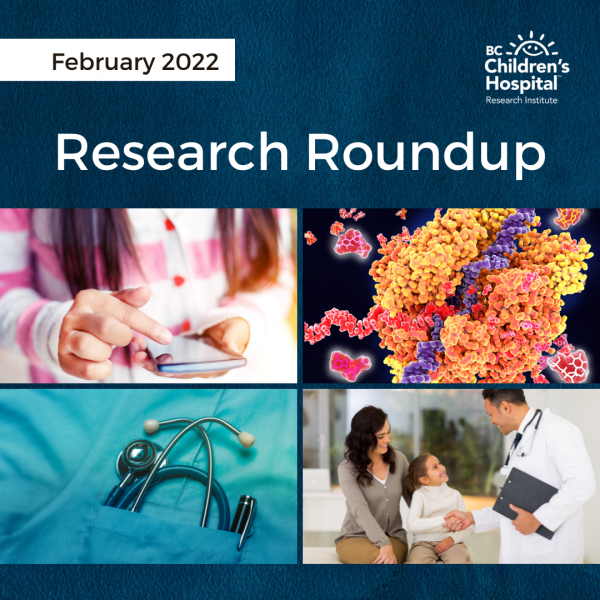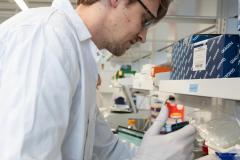Welcome to this month’s Research Roundup, a recurring overview of recent studies published by researchers at BC Children’s Hospital Research Institute (BCCHR) and the University of British Columbia, and their collaborators.

Text messaging platform improves care and provides hope for teen transplant recipients
BCCHR themes: Brain, Behaviour & Development, Evidence to Innovation and Childhood Diseases
Teens who have received solid organ transplants have ongoing medical needs as well as unique health risks related to their age. For example, the adolescent period has been associated with missed doses of medication, non-compliance with other medical recommendations and insufficient education about their condition. These behaviours can increase the chance of transplant rejection, loss of the transplanted organ, unnecessary interventions, lower quality of life and added medical costs. Even those who are highly motivated and engaged in their clinical care may welcome increased communication with their health-care team and the ability to ask questions and voice concerns as they arise.
Dr. Kathryn Armstrong, Dr. Steven Rathgeber, Dr. Sarah Hutchison, Astrid De Souza, Dr. Richard Lester, Dr. Tom Blydt-Hansen, Dr. Derek Human, Dr. Orlee Guttman and Dr. Tim Oberlander tested whether a new text-based communication platform provided by WelTel Inc. could help prevent some challenges and provide an additional way for patients to contact their health-care team outside of scheduled clinic visits. They worked with 23 organ transplant recipients, aged 12-19, to test a SMS platform for approximately one year.
“We know that over 91 per cent of teens already use text messaging, and this trend presents an opportunity to provide confidential, two-way communication between patients and their health-care team,” said Dr. Armstrong. “Although participants in our study already had a high quality of life and excellent medication compliance, they still saw benefits from the text-based communication platform, with four out of five saying they would recommend it to other transplant patients.”
Many of the teens also said they liked getting a check-in from their care team every week.
“The teens in our study felt more supported and had a more positive outlook about their post-transplant health outcomes,” said Dr. Armstrong. “We have adopted the text-based communication platform into regular care in our clinic and believe that it may translate to other adolescent populations with ongoing and/or complex medical needs.”
Read more in “A Text Messaging Intervention and Quality of Life in Adolescents With Solid Organ Transplants,” Pediatric Transplantation.

The Rare Disease Discovery Hub uncovers genetic mechanism that may lead to milder forms of Alkuraya-Kucinskas syndrome
BCCHR themes: Childhood Diseases and Healthy Starts
The Rare Disease Discovery Hub at BC Children’s Hospital is a multidisciplinary, translational research program that helps children affected by undiagnosed “mystery” conditions by discovering the cause of their disease and gaining understanding of how that disease works. The Hub solves the puzzle of these rare and ultra-rare conditions, defines treatment targets and improves health outcomes for children and their families.
Recently, the Hub’s Dr. Cornelius Boerkoel, Dr. Stuart Turvey, Dr. Anna Lehman, Dr. Hui-Lin Chin, Susan Lin, Joshua Dalmann, Dr. Bhavi Modi, Emily Alderman, Areesha Salman and Kate Del Bel worked with a family that had an ultra-rare KIAA1109 gene variant associated with Alkuraya-Kucinskas syndrome, an often severe neurodevelopmental disorder. The father had one copy of the allele but no symptoms, and the mother and daughter both had two copies of the allele. While the mother experienced some intellectual disability, the daughter was the most impacted and grew more quickly than others her age, experienced developmental delays, near-sightedness, mild narrowing of the pulmonary arteries, early signs of sexual maturation, central nervous system abnormalities and facial differences.
“Usually, when an individual has two copies of the KIAA1109 allele, they do not survive after birth. In some scenarios, such as in the family we had the pleasure of working with, certain genetic functions carried out during transcription may explain reduced disease severity,” said Dr. Turvey.
The team’s observations suggest a new explanation for milder presentations of Alkuraya-Kucinskas syndrome. Milder disease and disease variation could be explained by “leaky splicing” where some normal genetic function is retained or “leaks through.” This mechanism could also explain disease variation in many other genetic conditions.
“There may be several individuals and families impacted by undiagnosed Alkuraya-Kucinskas syndrome who have not yet been identified because their symptoms are not severe,” said Dr. Lehman.
“They would likely benefit from having their condition recognized so that various strategies could be put in place to help ensure health and longevity,” added Dr. Boerkoel.
Read more in “Can Leaky Splicing and Evasion of Premature Termination Codon Surveillance Contribute to the Phenotypic Variability in Alkuraya-Kucinskas Syndrome,” European Journal of Medical Genetics.

Children and youth with skin conditions face many barriers to health-care access
BCCHR theme: Evidence to Innovation
Barriers to health-care access are defined as factors that prevent patients or patient populations from obtaining necessary medical care. These barriers can include systemic barriers that arise from legal frameworks, governmental policies or institutional practices; sociocultural barriers that arise from group characteristics such as race/ethnicity, language or religion; and individual barriers that arise from personal characteristics such as medical or mental health conditions, previous experience with discrimination in health care or being overburdened with responsibilities at home.
While barriers to health-care access (BtHA) have been extensively studied in the context of adult dermatology, little research has been conducted to identify BtHA in pediatric dermatology. To fill this gap in knowledge, Dr. Wingfield Rehmus, Jeffrey Toy and Dr. Allison Gregory conducted a systematic review and found 12 research articles that fit their inclusion criteria.
“While the relatively low number of studies limits our ability to draw strong conclusions, we identified barriers related to finances, wait times, geography, cultural and ethnic beliefs, communication, and patient knowledge and perceptions,” said Dr. Rehmus.
In terms of systemic barriers, the team found that:
- for specific skin conditions, longer wait times were associated with increased missed appointments,
- Medicaid (a program that helps cover health-care costs for those with limited income) was not accepted by a sizable fraction of pediatric dermatologists in the United States,
- increased distance from a dermatologist was associated with lower adherence to treatments and higher odds of being lost to follow-up, and
- dermatology treatment costs presented a significant barrier for one Canadian community with low socioeconomic status.
In terms of sociocultural barriers, the team found that:
- language barriers sometimes led to misunderstandings during consultations and resulted in incorrect use of skin medication,
- the increase in teledermatology was linked to a decrease in the number of Spanish speakers accessing pediatric dermatological care, and
- cultural beliefs, such as the belief that acne is a right of passage, led to people not seeking health-care services.
In terms of individual barriers, the team found that:
- some young people were too embarrassed to seek care for their skin conditions, and
- some misjudged the severity of their condition and refrained from seeking care.
Read more in “Barriers to Healthcare Access in Pediatric Dermatology: A Systematic Review,” Pediatric Dermatology.




